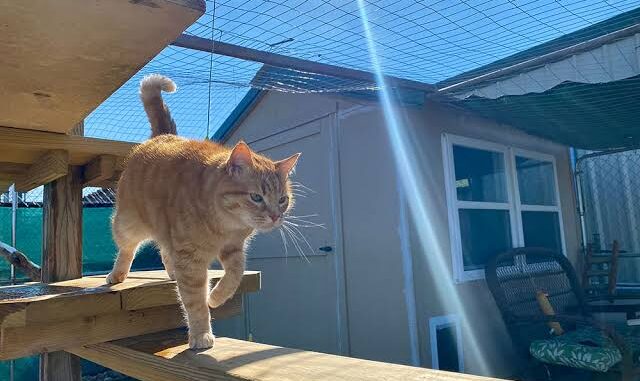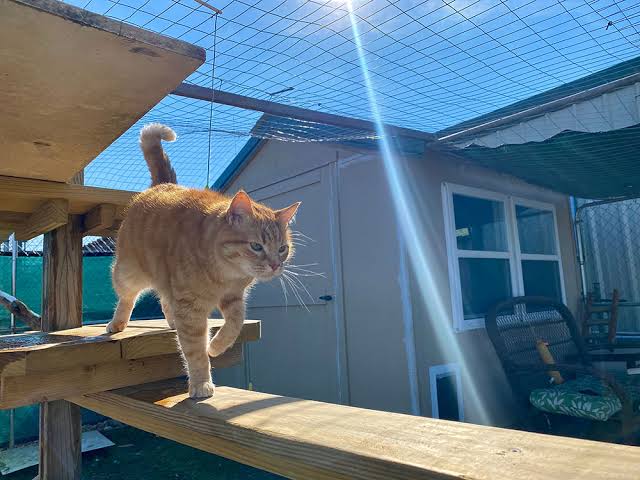
How to Create a Safe Outdoor Space for Cats: Cats are natural explorers. The outdoors offers them sights, smells, and sounds that indoor environments can rarely match. However, letting cats roam freely outside comes with risks from traffic and predators to diseases and toxic plants. The solution? Creating a safe outdoor space where your cat can experience the benefits of fresh air and stimulation without the dangers.

This guide covers everything you need to know to build a safe, enriching outdoor space tailored to your cat’s needs. Plus, you’ll find answers to common questions to help you make the best choices for your feline friend.
Why Give Your Cat Outdoor Access?
Outdoor access can:
- Provide mental stimulation and reduce boredom
- Encourage physical exercise to maintain a healthy weight
- Let your cat satisfy natural instincts like hunting and climbing
- Reduce indoor behavioral problems caused by confinement
- Enhance your cat’s overall quality of life
But uncontrolled outdoor roaming is dangerous. Outdoor cats face:
- Car accidents
- Predators like coyotes, dogs, or birds of prey
- Exposure to parasites, infectious diseases, and poisons
- Getting lost or stolen
- Conflicts with neighbors or wildlife
A safe outdoor space balances freedom with protection.
Types of Safe Outdoor Spaces for Cats
1. Catios (Cat Patios)
Catios are enclosed patios or balconies designed exclusively for cats. They can be simple or elaborate and attached to windows, doors, or balconies.
- Usually made with wire mesh or plexiglass
- Provide fresh air and sunshine safely
- Allow your cat to climb, perch, and explore
2. Freestanding Enclosures
These are standalone outdoor cages or structures placed in your yard.
- Offer protection from predators and escape-proof fencing
- Often include climbing structures and resting areas
- Portable models allow repositioning
3. Leash and Harness Training
A less permanent option, where your cat wears a harness and leash for supervised outdoor time.
- Requires training and patience
- Allows controlled exploration of the yard or park
4. Backyard Fencing Modifications
Adding cat-proof fencing or barriers to your existing yard fence.
- Includes “cat rollers” or inward-angled fence toppers
- Keeps your cat in and other animals out
Steps to Create a Safe Outdoor Space for Your Cat
Step 1: Choose the Right Location
- Consider proximity to busy streets or hazards
- A shaded area protects from overheating
- Easy access from your home encourages frequent use
Step 2: Enclose the Area Securely
- Use sturdy wire mesh or hardware cloth with small openings (½ inch or less) to prevent escape and keep predators out
- Ensure the enclosure is fully covered — cats can climb or jump out
- Check for gaps or weaknesses regularly
Step 3: Provide Enrichment
- Add shelves, ramps, and climbing trees for vertical space
- Place scratching posts or pads
- Include hiding spots and cozy beds
- Add sensory elements like cat-safe plants (catnip, cat grass)
Step 4: Add Water and Shelter
- Always have fresh water available
- Provide shelter or covered areas for shade and rain protection
Step 5: Use Safe Materials
- Avoid toxic plants, sharp edges, or harmful chemicals
- Use weather-resistant, non-toxic materials for construction
Step 6: Maintain Cleanliness
- Clean litter boxes or trays regularly if used outdoors
- Remove fallen leaves, debris, and standing water to prevent pests
Step 7: Train and Supervise
- Introduce your cat gradually to the outdoor space
- Supervise initial visits until you’re confident in the security
- Use positive reinforcement to encourage good behavior
Essential Safety Tips
- Microchip and ID tag: Even in an enclosed space, accidents happen. Microchip your cat and ensure they wear a collar with updated ID.
- Regular Vet Check-ups: Outdoor exposure increases risk of parasites and infections; maintain vaccinations and flea/tick prevention.
- Monitor Weather: Don’t leave cats outdoors in extreme heat, cold, or storms.
- Check for Wildlife: Ensure no wild animals can access the enclosure.
- Avoid Toxic Plants: Common outdoor plants like lilies, azaleas, or oleander are toxic to cats.
READ ALSO: The Mystery of the Tortoiseshell Cat: A Tale of Colors, Myths, and Meaning
Benefits of a Safe Outdoor Space
- Improves mental and physical health
- Reduces stress, anxiety, and destructive behavior
- Strengthens your bond by spending quality time together outdoors
- Provides a secure way to enjoy natural sunlight and fresh air
Common Challenges and How to Overcome Them
Cats Trying to Escape
- Reinforce the enclosure’s roof and corners
- Use deterrents like aluminum foil or cat repellent mats on edges
Introducing Multiple Cats
- Provide separate levels and hiding spots to reduce territorial disputes
- Monitor interactions closely during initial introductions
Weather-Related Concerns
- Add insulated shelters or heated beds for winter
- Provide ample shade and water in summer
Cleaning and Maintenance
- Design the enclosure for easy access to clean floors and surfaces
- Schedule regular checks for wear and tear
FAQs
Can outdoor cats live longer if confined to safe spaces?
Yes, cats confined to safe outdoor spaces typically live longer because they are protected from traffic accidents, predators, and diseases.
Do cats get bored in enclosed outdoor spaces?
Not if the space is enriched with toys, climbing structures, and sensory stimulation. Rotate toys and add new elements regularly to keep your cat engaged.
How big should a safe outdoor space be?
Ideally, larger is better. A minimum of 8×8 feet is good for small enclosures, but even small spaces with vertical levels can be enriching.
Is it safe to have plants in my cat’s outdoor space?
Yes, but only cat-safe plants like catnip, cat grass, and valerian. Avoid any known toxic plants such as lilies, daffodils, or azaleas.
How do I get my cat used to a new outdoor enclosure?
Introduce your cat slowly by allowing short supervised visits initially. Use treats and praise to make the experience positive.
Can I build a DIY catio myself?
Absolutely! Many catios can be built with basic carpentry skills using wire mesh, wood, and PVC. There are plenty of online plans and kits.
Should I let my cat roam freely outdoors if I have a catio?
It’s safer to keep cats within the enclosure, as free roaming exposes them to many risks. The catio provides a safer alternative.
What materials are best for outdoor cat enclosures?
Use galvanized wire mesh or hardware cloth to prevent rust and biting through. Wood should be weather-treated and non-toxic.
How can I prevent other animals from entering the cat enclosure?
Ensure the enclosure is fully enclosed with a secure roof. Use locks on doors and reinforce any potential weak spots.
Are outdoor spaces suitable for older or sick cats?
Yes, but make sure the space is accessible with ramps and shaded areas. Monitor your cat’s health and comfort closely.
Leave a Reply
You must be logged in to post a comment.